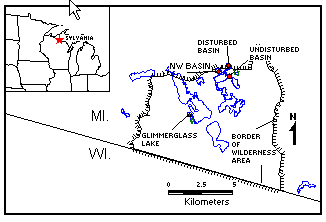Holocene vegetation history in the Sylvania Wilderness
Area of the Western Upper Peninsula of Michigan. American Midland
Naturalist
Richard B. Brugam, Carmen Sesvold, Melody Giorgi and Rodney Almos

Figure: Locations of Sites in the Upper Peninsula of Michigan
Figure: Locations of Study Sites in Michigan
Sediment cores spanning the last 10000 years from two lakes in
the Sylvania Wilderness Area of the Upper Peninsula of Michigan
were analysed for pollen, and the pollen data were compared with
the National Geophysical Data Center (NGDC) data set of modern
pollen samples. The best modern analogue for the spruce pollen
zone (>9000 BP) at the bottom of Glimmerglass Lake was a sample
located near Hudson's Bay in Quebec. This zone was not present at
Crooked Lake. Modern samples matched the samples from the
diploxylon pollen zone (9000 to 8000 BP) poorly. Samples
analogous to those from the haploxylon pollen zone (8000 to 3000
BP) come from eastern Minnesota and western Wisconsin. Samples
dating from after the arrival of Tsuga (at 3000 BP) are similar
to modern surface samples from Sylvania. The surface sample
analogues suggest that the arrival of Tsuga at 3000 BP marks the
establishment of the modern "lake effects" climatic regime in the
Upper Peninsula.

Glimmerglass Lake and Bog in the Sylvania Wilderness Area

Return to Brugam's Homepage



